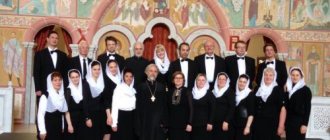Should believers celebrate March 8?
The tradition of celebrating this day has firmly entered Russian life, but Orthodox believers do not forget the history of this celebration. Christians always remember that the roots of the bloody revolution sprouted deep here.
Believers do not need to celebrate this event. According to the traditions of Orthodoxy, women are congratulated and honored during the holy week of the Myrrh-Bearing Women, which glorifies those mothers who personally welcomed the Son of God and accompanied him to Calvary. They were the first to bring the joyful news of the resurrection of Jesus Christ, which dispelled the sorrow of many followers of Christianity.
About women in Orthodoxy:
- Holy women equal to the apostles in Orthodoxy
- Icon of the Myrrh-Bearing Women
Icon of the Holy Myrrh-Bearing Women
- The Church sometimes compares the feminine ideals of the two holidays. For March 8, she is an emancipated revolutionary with the distinctive moral characteristics of a man, and for the Orthodox day, she is a sensitive, caring, faithful and loving Christian mother, sacrificing her life for the sake of faith in the One God.
- The celebration of the eighth of March often coincides with the days of Great Lent, which encourages believers to abstain from certain foods, sexual relations and manifestations of uncontrollable joy. Therefore, the Church criticizes this holiday in every possible way.
- The Orthodox tradition has its own foundations and calendar of memorable dates. Every religious holiday teaches something moral and virtuous, and the pious lives of the saints are a shining example for humble imitation. The Day of the Myrrh-Bearing Women instructs believers in love and devoted service to the Lord. The founders of the day of March 8 did not have as their goal to teach people high morality.
- An Orthodox person should treat March 8th as an ordinary secular celebration. There are even ardent opponents of this celebration in the world who want its abolition. However, even its cancellation will not affect the opinion of the Church, because religion does not ascribe any importance to March 8th.
- For Orthodoxy there are no gender differences; what is important is correct behavior that does not contradict the ten main commandments of the Holy Scriptures. The church calendar is designed to honor the memory of every man or woman.
- The mission of religiosity is to fill the population with the spirit of true humility. Priests sometimes wonder why a holiday with revolutionary principles has overshadowed the celebration of the Myrrh-Bearing Women, which glorifies patience and love. The task of the Orthodox believer is to maintain the main church celebrations in order to replenish and revive the spirit of religiosity.
March 8 - Orthodox view
- Orthodox people who do not recognize March 8 do not create obstacles for worldly people, because they adhere to the religious motto “Rejoice with those who rejoice!”
On a note! On this day, it is quite acceptable to give women small gifts and shower them with warm congratulations. However, it is necessary to remember: this worldly holiday is included in the calendar framework of Great Lent. Therefore, the believer is obliged to devote this time to prayer and reflection.
Polikarpov day
Hieromartyr Polycarp of Smyrna, bishop.
The church celebrates the memory of Saint Polycarp, originally from the city of Smyrna in Asia Minor. He was a bishop. He accepted martyrdom for his faith in Jesus Christ under Emperor Aurelius. He was burned at the stake.
Saint Polycarp, Bishop of Smyrna, was born around 80, lived in Asia Minor, in the city of Smyrna. Left an orphan early, he was raised at the direction of the Angel by the pious widow Callista. After the death of his intended mother, Polycarp distributed his estate and began to lead a chaste life, serving the sick and infirm. The holy Bishop of Smyrna Vukol (February 6) fell in love with him and brought him closer to him. He ordained Polycarp as a deacon, instructing him to preach the Word of God in the temple.
At that time, the holy Apostle John the Theologian was alive. Saint Polycarp was especially close to Saint John the Theologian, whom he accompanied on his apostolic travels. Saint Vukol ordained Saint Polycarp as a presbyter, and shortly before his death he bequeathed to install him as a bishop in the See of Smyrna. When Saint Polycarp was consecrated as a bishop, the Lord Jesus Christ appeared to him.
Saint Polycarp led his flock with apostolic zeal. He enjoyed great love among the priesthood. Saint Ignatius the God-Bearer treated him with great warmth. Going to Rome, where execution awaited him (he was torn to pieces by wild animals), he wrote to Saint Polycarp:
“Just as the helmsman needs the winds, or the stormy needs a pier, so the present time needs you in order to reach God.”
Emperor Marcus Aurelius (161-180) ascended the Roman throne, and one of the most severe persecutions was instituted against Christians. The pagans demanded that the judge look for Saint Polycarp - “the father of all Christians” and “the seducer of all Asia.” At this time, Saint Polycarp, at the urgent request of his flock, stayed in a small village not far from Smyrna.
When the soldiers came for him, Saint Polycarp came out to meet them and ordered them to be fed, and at that time he himself began to pray, preparing for martyrdom. His suffering and death are described in the “Message of the Christians of the Smyrna Church to other Churches” - one of the most ancient monuments of Christian writing. Having been brought to trial, Saint Polycarp firmly confessed his faith in Christ and was sentenced to be burned. The executioners wanted to nail him to a post, but he calmly told them that he would not leave the fire, and they only tied him with a rope. The flame surrounded the saint, but did not touch him, closing in the air above his head. Seeing that the fire was not harming him, a crowd of pagans and Jews began to demand that he be killed with the sword. When Saint Polycarp was wounded, so much blood flowed out that it extinguished the flame. The body of the holy martyr Polycarp was burned. The Christians of Smyrna reverently collected his honest remains, sacredly honoring his memory.
A story about Saint Polycarp by his disciple, Saint Irenaeus of Lyons, has been preserved, which Eusebius cites in his “Ecclesiastical History” (V, 20):
“I was still very young when I saw you in Asia Minor with Polycarp,” Saint Irenaeus addresses his friend Florinus, “...I could now indicate the place where blessed Polycarp sat and talked, I could depict his gait, his way of life , appearance, his conversations with the people, his friendly behavior with John, as he himself said, and with other witnesses of the Lord - the way he recalled their words and retold what he heard from them about the Lord, His teaching and miracles... According God's mercy to me, even then I listened attentively to Polycarp and wrote down his words not on the board, but in the depths of my heart... So, I can testify before God that if this blessed and apostolic elder had heard something similar to your error, then he would immediately block his ears and express his indignation with the usual saying: “Good God! How long have you allowed me to live?”
During his lifetime, the saint wrote several Epistles to his flock and letters to various persons. His Epistle to the Philippians has reached our time, which, according to Blessed Jerome, was read in the churches of Asia Minor during divine services. It was written by the saint in response to the request of the Philippians to send them the letters of the Hieromartyr Ignatius the God-Bearer, preserved by St. Polycarp.
History of the holiday March 8
The date is associated with the name of the active communist and feminist Clara Zetkin. She spent a lot of effort in order to defend the rights of the weak half of humanity. At the beginning of its creation, the celebration had a colossal political connotation.
About other secular holidays:
- Is it possible for Orthodox Christians to celebrate the New Year?
- Orthodox Church about Valentine's Day
- About Halloween
- It was on March 8, 1857 that New York textile workers marched in what became known as the “Empty Pans” March. These American women workers demanded wages equal to men's, shorter working hours, and significant changes in conditions.
- From that moment on, many representatives of the fairer sex on the American and European continents made feminist statements.
- 50 years later, on the streets of the same New York, 15,000 women held a demonstration timed to coincide with the “empty pots” march. They again demanded equal wages to men, a reduction in working hours and improved conditions for their hard work. They added to their statements a protest against the exploitation of children, as well as a demand for official voting in the elections.
- A year later, the strike on March 8 was repeated, and in 1910 it was spread throughout the United States. A delegation of American socialist feminists went to a conference in Denmark, where they met K. Zetkin and R. Luxemburg. The latter were uncompromising fighters against the ideas that bound the women of Germany. They demanded that male society give them a free hand and stop oppressing them with the concepts of children, kitchens and churches. Socialist feminists sought average wages and the opportunity to obtain leadership positions in various organizations.
History of the origin of March 8
- K. Zetkin proposed setting a specific date when women will attract public attention to their own problems. Many feminists supported this impulse and joined the active struggle for social equality. A special conference supported this project, and International Women's Day was born.
- The very first celebrations were held on March 19, in 1912 - on May 12, and only two years later the date was finally established on March 8.
On a note! Among the secular population of our country, the triumph of the Myrrh-Bearing Women is practically unknown. The laity does not pay attention to women on the third Sunday after Easter. However, it is precisely this celebration that remembers the best qualities of our mothers, spouses, sisters, grandmothers, etc. For secular society today, only March 8 is honored.
Features of the service:
On the week (Sunday) of the Triumph of Orthodoxy, after the liturgy, the Rite of the Triumph of Orthodoxy is served. This is a special prayer service, during which the triumph of the Church over all heresies that have ever existed is proclaimed and the true glorification of God is affirmed, according to the teachings of the Church.
Troparion of the holiday
The troparion of the holiday is the troparion to the image of the Savior not made by hands:
We worship Your most pure image, O Good One, / asking forgiveness of our sins, O Christ God, / for by the will of You you deigned to ascend in the flesh to the Cross, / so that You may deliver what You have created from the work of the enemy. / With this cry of gratitude You filled all with joy , Our Savior, who came to save the world.
Translation: We worship Your most pure image, O Good One, asking forgiveness of our sins, O Christ our God. For You voluntarily deigned to ascend in flesh to the Cross in order to deliver those created by You from slavery to the enemy. Therefore, we gratefully cry out to You: “You filled everything with joy, our Savior, / who came to save the world!”
Kontakion of the holiday:
The indescribable Word of the Father, / from You, Mother of God, we incarnate, / and we imagine the defiled image into the ancient, / with the divine goodness of the mixture, / but confessing salvation, / / we imagine this in deed and word.
Translation: The indescribable Word of the Father, during the Incarnation, was depicted from You, Mother of God, and recreated the defiled image in its original form, uniting it with Divine beauty. And we, confessing our salvation, depict it in deed and word.
What is troparion and kontakion read here









